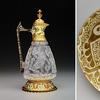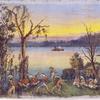HIGHLIGHTS FROM THE ART AND ANTIQUE DEALERS LEAGUE SPRING SHOW NYC TANTALIZE EVERY TYPE OF BUYER— FROM MUSEUM EXPERT TO NEOPHYTE
- NEW YORK, New York
- /
- April 23, 2012
Astute organizers of art and antique fairs pursue a dual mission. On the one hand, they must appeal to museum professionals and seasoned buyers, and on the other, they want to welcome neophytes. No art and antiques fair anywhere in the world fulfills those two goals with more aplomb than the Spring Show NYC, which opens on May 3 and runs through May 6 at the Park Avenue Armory. There, in a hospitable, non-intimidating setting, fairgoers of all backgrounds are comfortably united in awe and appreciation of the wide range of the fair’s offerings.
Spring Show NYC dealers were asked to select two highlights: one for a hypothetical museum curator, and another for the novice collector. Here are some of their choices, with asking prices when available:
Furniture and Decorative Arts
L’Antiquaire & The Connoisseur will feature an enchanting marriage coffer decorated with an apt nuptial symbol of fertility, the rabbit. Perfect for a museum, this large and unusually well-preserved box has a sliding lid that reveals a compartment, and among its many polychrome decorations is a pomegranate tree, another symbol of fecundity (asking price $120,000).
For the novice collector, gallery owner Helen Fioratti recommends a pair of 1920s colored prints entitled Stylized Women in Paris, by Umberto Brunelleschi, who achieved their charming effect through watercolor, ink and gouache (asking price $7,000).
At Carlton Hobbs, decorative arts curators will be drawn to the Warren Hastings Writing Box, which bear the arms of its owner Warren Hastings. This mid-18th century box is a superb example of the craftsmanship typical of Indian cabinetmakers working during the period. Larger than many known specimens, it contains an array of beautifully worked drawers on the inside, further enhanced with tortoiseshell veneer complementing the bands of ivory on the interior. For those just starting a collection, Hobbs recommends a French Bois Satine and brass mounted library cabinet by Alfred Porteneuve, the nephew of Jacques-Emile Ruhlmann, circa 1935.
Clinton Howell, an expert in 18th- and 19th-century English furniture and decorative arts, is offering a superb pair of marquetry-inlaid demi-lune consoles, attributed to the workshop of John Linnell. These fine, circa-1775 masterpieces would be right at home in the decorative arts collection of a museum. For newcomers, Howell recommends a pair of candlesticks made of red-and-green Purbeck marble, found in Dorset in southwest England but no longer quarried, and originally marketed in the early 19th century to the tourist trade.
Hyde Park is putting forth a pair of circa-1765 George III commodes in the manner of Pierre Langlois and bearing the original in-tact paper label: “Formerly the property of Fanny, Lady Leon, Bletchley Park, Buckinghamshire.” Ripe for a museum, each commode has the three long drawers executed with the finest veneers and retaining original elaborate foliate cast handles and escutcheons (asking price $340,000). Fledging collectors should take note of a circa-1812 Regency rosewood center table with vibrant satinwood banding. It is a superb example of Regency design, with exotic woods and brass-line inlay (asking price $18,000).
For a museum collection, Mary Helen McCoy selected as her highlight an armoire from the Lorraine, France. This magnificent piece has exquisite floral marquetry set off with a tinted ivory inlay (asking price $68,000). For the starting collector, Mary Helen McCoy recommends a pair of French 18th-century wallmountable faience plaques (asking price $3,600). Suitable for a museum is the miniature chest of drawers presented by Michael Pashby. It is dated 1728 and inscribed by the maker Thomas Reynolds—the earliest documented chest of drawers with original bracket feet known. For the benefit of new patrons to the Spring Show NYC, Michael Pashby calls attention to an exemplary pair of hall chairs designed by Thomas Hope and dated to exactly 1795. They represent the best of their type, and thus exemplify what, he
recommends, “a new collector should always strive for.”
The mania for all manner of contemporary interior design is reflected in the offerings of Craig Van Den Brulle. For his museum selection, Van Den Brulle points to a Riemann cast-stainless-steel chair, a piece that marks a new period of furniture design as art in the 21st century (asking price $120,000). And for new collectors, he recommends a Jean Claude Dresse etched bronze coffee table with inlayed agate stones (asking price $50,000).
Kentshire Galleries has a piece fit for the finest museums: a specimen marble table by Raffaelli, a master in his field. It comes with a hand-written document that provides a guide to each specimen of marble, many of which are long since extinct. With new fairgoers in mind, Kentshire spotlights a sign bearing the image of a lion. The sign has superb patina and it has remarkable provenance. Celebrated architect Sanford White displayed it prominently in his New York City townhouse.
Jason Jacques is steering museum curators towards a very rare vase in budding style created by Salto (asking price $180,000). A collection of collotypes on handmade Japon paper from the portfolio Das Werk Gustav Klimts is ideal for brand-new purchasers. Printed in Vienna between 1908 and 1914, these multicolor collotypes, made from 16 separate plates, depict Klimt’s most important paintings from 1898 to 1913, and they represent one of the greatest artistic and technical achievements in 20th-century printmaking (asking price $15,000).
Sundial has on view an astronomical skeleton table regulator clock, circa 1842, with remontoire and quarter-striking by Detouche. It is the earliest of only about five really great pieces by Detouche and belongs in a museum (asking price $250,000). For someone just starting to make acquisitions in the world of timepieces, there is a circa-1830 miniature English inlaid-rosewood and silver-bracket clock by Payne —a very interesting example of a common model, with a silver dial, wind up/down indicator and balance escapement. A new collector might see others like it, but none would be as good (asking price $11,500).
For museum collection, Earle Vandekar of Knightsbridge is putting focus on a Massive Leeds Pottery Pearlware horse, Circa 1820-30. “This is one of the rarest forms of English pottery,” said Paul Vandekar. “Only two examples exist. One is at the Glasgow Museum of Art and the other in Temple Newsom in Leeds.” (asking price $75,000). New eyes to the Spring Show NYC should take a look at H.M.S. Boscawen, circa 1860-70, and signed S. Veal. Signed woolies are very rare, especially with a full name rather than just initials (asking price $9,000).
Paintings
Lawrence Steigrad Fine Art presents Chacun Pour Soi by Philippe Rousseau, known primarily as a painter of animals and still lifes. This monumental, ripe-for-a-museum work has continued to win applause ever since it was first unveiled at the Paris Salon in 1865 (asking price $130,000). For a novice collector comes a recommendation for John MacVicar Anderson’s colorful panorama entitled Somerset House, St. Paul’s and Waterloo Bridge, London, a breathtaking example of site-specific genre paintings so highly esteemed by both painters and collectors in the 18th and 19th centuries (asking price $55,000).
The oil portrait of Katherine Rhoades offered by Avery Galleries is a rare exploration of color and abstraction by celebrated artist Arthur B. Carles (1882-1952), making it tailor-made for a museum collection. Circa 1912, the portrait reflects essential elements of representational art while also showing off new devices of American Modernism in its early stages (asking price $185,000). With new collectors in mind, Avery Galleries puts Stanley Laurence Reckless’s Autumn in New Hope center stage. This is a work by a Pennsylvania Impressionist artist (1892-1955) whose paintings seldom come to market. It is signed both on verso and recto and is in its original, signed Yates frame (asking price $35,000).
Presented by Questroyal Fine Art, a depiction of one of America’s most iconic landscapes, Old Faithful, by American master Albert Bierstadt, Hudson River School artist par excellence, rightfully belongs in a museum for everyone to enjoy (asking price $700,000). For those new to field is William M. Hart’s Autumn Afternoon, a classic American landscape by an influential artist who lived from 1863 to 1894 (asking price, under $25,000).
With museum curators in mind, Thomas Colville Fine Art is offering Alfred Stevens’ La Psyché, a circa-1871 work by the Belgian painter (1823-1906), active in the Paris Salon (asking price $400,000). For neophyte collectors, Thomas Colville points up Evening Among the Ruins by A.B. Davies, a beautiful 1902 example by a member of the Eight, as well as an early American Modernist (asking price, under $20,000).
From Daphne Alazraki Fine Art comes River Landscape with a Cattle Ferry by Salomon van Ruysdael, a piece that would be very at home in a museum collection. The theme is one that the artist revisited throughout his career, and the muted tonalities are representative of his later work, often considered by critics to be van Ruysdael’s best period. For collection-builders just starting out, Ms. Alazraki recommends a Marie Laurencin portrait titled Jeune fille à la guitar.
Jewelry
Arthur Guy Kaplan, is showing a museum-quality French cameo suite set in 18k gold. The finely carved cameos are consummately framed in pearls and rubies. Although the suite is unsigned, it is of the highest quality and still in the original presentation case. A memorial pendant locket, circa 1790, containing a beautifully rendered miniature plinth and urn with the inscription: Sacred to the memory of a mother is an ideal piece with which to start a collection. The weeping tree and background are done in hair.
Kentshire Galleries is also recognized for jewelry and this year they will have an important Cartier Art Deco diamond necklace suspending a carved crystal pendant watch with an inset diamond motif of concentric circles and a diamond surround in platinum. And for the young collector, Kentshire’s jewelry expert Ellen Israel suggests an antique oval gold locket in the Etruscan style with applied wire work and granulation.
Silver
From Spencer Marks, Ltd. comes silver that would make a prized addition to a museum collection: A very rare Wiener Werkstatte coffee service designed by Josef Hoffmann in 1925 and comprising a coffee pot, similarly-sized hot milk jug (for café au lait), and covered sugar bowl. Only three services in this design—two coffee and one tea—were ever made (asking price $44,000). For the young collector, there is a Tiffany salver designed in the Japanese taste (asking price $5,900).
Tribal Art
At Douglas Dawson, curators will be drawn to the legendary Thai monk, Phra Malai, represented here in a superb gilt bronze casting of the Rattanakosin Period (early 19th century Thailand). Castings of this period are valued for the exquisite detail, particularly depictions of textiles, achieved by master artisans. While most castings of this period depict the Buddha, this piece represents the mythological monk who moved between heaven and hell to advise mortals on how to achieve one and avoid the other. African ceramics are an excellent starting point for beginning collectors. Examples of the highest quality remain inexpensive and increasingly desirable including this enormous terra-cotta pipe, which dates to the 1920s, belonged to a queen of the Cameroon.
Pre-Columbian Art
Year by year, Latin American art continues to build a more international profile, and William Siegal plays a role in that development. The first-time Spring Show NYC exhibitor will present a museum-quality limestone Atacama caliche stone figure from 500 to 2500 B.C., one of only a handful of known examples. And for those who want to start collecting tribal art, Siegal recommends a terra-cotta dog from Colima in western Mexico that is 2,000 years old and in pristine condition.

100x100_n.jpg)
100x100_c.jpg)













